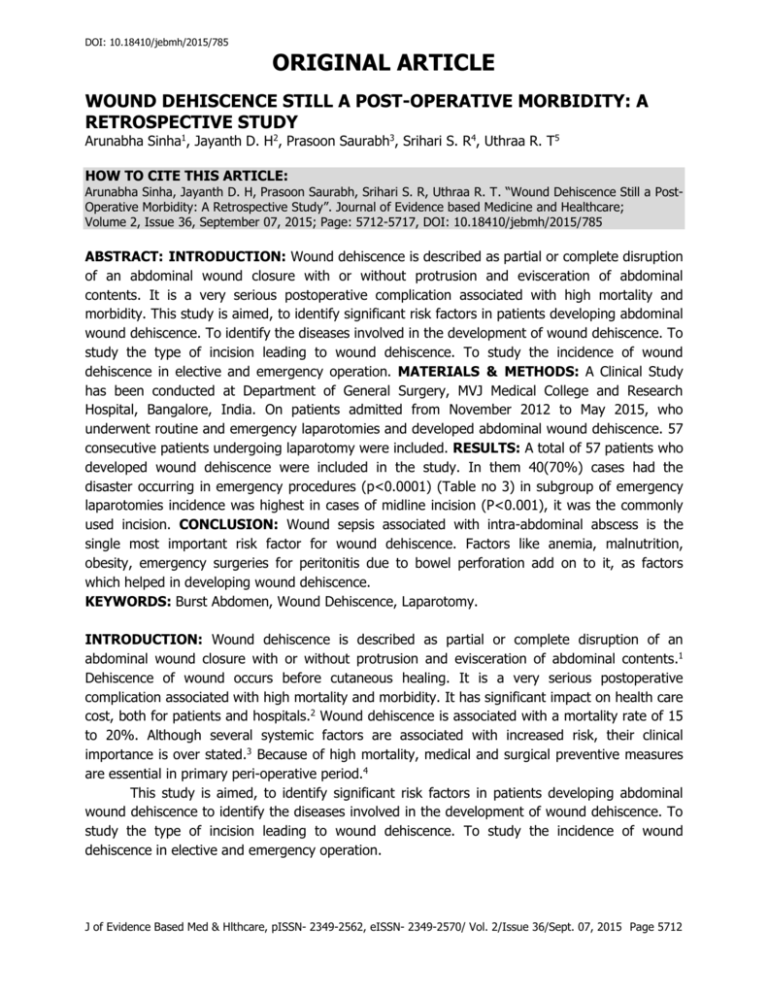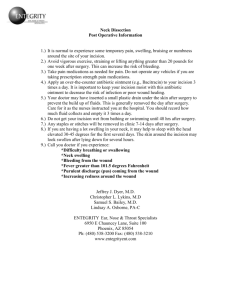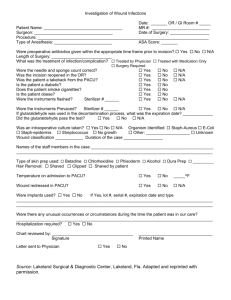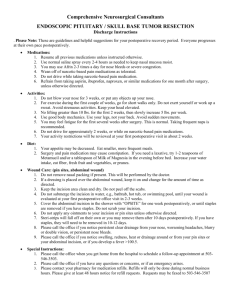Arunabha Sinha, Jayanth D. H, Prasoon Saurabh, Srihari S. R
advertisement

DOI: 10.18410/jebmh/2015/785 ORIGINAL ARTICLE WOUND DEHISCENCE STILL A POST-OPERATIVE MORBIDITY: A RETROSPECTIVE STUDY Arunabha Sinha1, Jayanth D. H2, Prasoon Saurabh3, Srihari S. R4, Uthraa R. T5 HOW TO CITE THIS ARTICLE: Arunabha Sinha, Jayanth D. H, Prasoon Saurabh, Srihari S. R, Uthraa R. T. “Wound Dehiscence Still a PostOperative Morbidity: A Retrospective Study”. Journal of Evidence based Medicine and Healthcare; Volume 2, Issue 36, September 07, 2015; Page: 5712-5717, DOI: 10.18410/jebmh/2015/785 ABSTRACT: INTRODUCTION: Wound dehiscence is described as partial or complete disruption of an abdominal wound closure with or without protrusion and evisceration of abdominal contents. It is a very serious postoperative complication associated with high mortality and morbidity. This study is aimed, to identify significant risk factors in patients developing abdominal wound dehiscence. To identify the diseases involved in the development of wound dehiscence. To study the type of incision leading to wound dehiscence. To study the incidence of wound dehiscence in elective and emergency operation. MATERIALS & METHODS: A Clinical Study has been conducted at Department of General Surgery, MVJ Medical College and Research Hospital, Bangalore, India. On patients admitted from November 2012 to May 2015, who underwent routine and emergency laparotomies and developed abdominal wound dehiscence. 57 consecutive patients undergoing laparotomy were included. RESULTS: A total of 57 patients who developed wound dehiscence were included in the study. In them 40(70%) cases had the disaster occurring in emergency procedures (p<0.0001) (Table no 3) in subgroup of emergency laparotomies incidence was highest in cases of midline incision (P<0.001), it was the commonly used incision. CONCLUSION: Wound sepsis associated with intra-abdominal abscess is the single most important risk factor for wound dehiscence. Factors like anemia, malnutrition, obesity, emergency surgeries for peritonitis due to bowel perforation add on to it, as factors which helped in developing wound dehiscence. KEYWORDS: Burst Abdomen, Wound Dehiscence, Laparotomy. INTRODUCTION: Wound dehiscence is described as partial or complete disruption of an abdominal wound closure with or without protrusion and evisceration of abdominal contents.1 Dehiscence of wound occurs before cutaneous healing. It is a very serious postoperative complication associated with high mortality and morbidity. It has significant impact on health care cost, both for patients and hospitals.2 Wound dehiscence is associated with a mortality rate of 15 to 20%. Although several systemic factors are associated with increased risk, their clinical importance is over stated.3 Because of high mortality, medical and surgical preventive measures are essential in primary peri-operative period.4 This study is aimed, to identify significant risk factors in patients developing abdominal wound dehiscence to identify the diseases involved in the development of wound dehiscence. To study the type of incision leading to wound dehiscence. To study the incidence of wound dehiscence in elective and emergency operation. J of Evidence Based Med & Hlthcare, pISSN- 2349-2562, eISSN- 2349-2570/ Vol. 2/Issue 36/Sept. 07, 2015 Page 5712 DOI: 10.18410/jebmh/2015/785 ORIGINAL ARTICLE AIMS AND OBJECTIVES: To identify significant risk factors in patients developing abdominal wound dehiscence. To identify the diseases involved in the development of wound dehiscence. To study the type of incision leading to wound dehiscence. To study the incidence of wound dehiscence in elective and emergency operation. MATERIALS & METHODS: A Clinical Study has been conducted at Department of General Surgery, MVJ Medical College and Research Hospital, on patients admitted from November 2012 to May 2015, who underwent routine and emergency laparotomies and developed abdominal wound dehiscence. Patients admitted in department of general surgery and underwent routine and emergency laparotomies who developed abdominal wound dehiscence where included in the study. Patients with previous laparotomies and Patients age below 18 years were excluded from the study. A detailed study of these patients were done as per Proforma regarding following factors:Underlying pathology, Emergency/Elective Laparotomy, Type of Incision, Type of Surgical Wound, Age, Haemoglobin (<10 g/dl), Hypoproteinaemia, Poor Nutritional status (BMI<18.5) Obesity (BMI>29.9), Diabetes Mellitus, Malignancy/Chemotherapy, Post- operative cough, Pulmonary Diseases with cough, Post- operative abdominal distension due to paralytic ileus, Post- operative vomiting, hiccough, or other straining factors, On the basis of above outcome and results, data was statistically analyzed to reach a definite conclusion regarding predictors leading to post-operative abdominal wound dehiscence. Inclusion Criteria: Patient admitted in department of general surgery and undergoing routine and emergency laparotomies who develops abdominal wound dehiscence after Laparotomy. Exclusion Criteria: Patients with previous laparotomies. Patients with age below 18 yrs. RESULTS: A total of 57 patients who developed wound dehiscence was included in the study, Out of these 2 patients had developed complete disruption of abdominal wound (burst abdomen). Whereas 40(70%) cases had the disaster occurring in emergency procedures (p<0.0001) (Table no. 3) in subgroup of emergency laparotomies incidence was highest in cases of midline incision (P<0.001), as it was commonly used incision (Table no 1). In emergency laparotomy group, hollow viscus perforation were 27 cases suggesting intra-abdominal sepsis as a risk factor, poor nutritional status, smoking, post-operative ileus and cough were found significant as the risk factors. (Table 3). Age No. of cases Percentage 18 – 27 13 22.80 28 – 37 12 21.05 J of Evidence Based Med & Hlthcare, pISSN- 2349-2562, eISSN- 2349-2570/ Vol. 2/Issue 36/Sept. 07, 2015 Page 5713 DOI: 10.18410/jebmh/2015/785 ORIGINAL ARTICLE 38 – 47 7 12.28 48 – 57 11 19.29 58 – 67 9 15.78 68 – 77 2 3.50 > 77 3 5.26 Table no 1: incidence of abdominal wound dehiscence in Different age groups Type of Incision No. of Cases Total Midline 41 71.92 Kocher’s 1 1.75 Roof Top 1 1.75 pfannenstiel 1 1.75 Loin 1 1.75 Appendicectomy incision 12 21.05 Total 57 Tabel no 2: Frequency of abdominal wound dehiscence in relation to type of incision Diagnosis No. of cases Hollow viscus perforation 21 Duodenal perforation 6 Appendicular pathology 12 Intestinal obstruction 6 Others 12 Table no 3: Various abdominal procedures leading to abdominal wound dehiscence No cases developed dehiscence(n=57) Hemoglobin(<10gm) 25 Emergency surgery 40 Obesity 12 Malnutrition 22 Post-operative cough 31 Post-operative vomiting 30 Post-operative ileus 31 Risk factors % 44% 70% 21% 39% 55% 54% 55% Table no 4: Risk factors leading to wound dehiscence J of Evidence Based Med & Hlthcare, pISSN- 2349-2562, eISSN- 2349-2570/ Vol. 2/Issue 36/Sept. 07, 2015 Page 5714 DOI: 10.18410/jebmh/2015/785 ORIGINAL ARTICLE DISCUSSION: In Our clinical study, a total of 57 cases that developed wound dehiscence were included. Spectrum of cases from complete disruption of abdominal wound (burst abdomen), to wound gaping were included and only 2 (two) cases with complete disruption of abdominal wound (burst abdomen) were present in our study. In a study conducted between 2007, 3500 abdominal laparotomies where performed in department of surgery of Mesologgi General Hospital and Urban Community Teaching Hospital,5 showed the incidence of abdominal wound dehiscence more commonly male gender 60%. In our study showed the incidence of abdominal wound dehiscence more commonly in male gender (80.70%). The mean age 43 years, as the incidence of appendicular perforation and duodenal ulcer perforation is more common in this age group. Study conducted on 107 patients with abdominal wound dehiscence over a period of 7 years in Department of Surgery, Case Western, Reserve University, Cleveland Veterans Affair‘s Medical Centere USA6,showed that patients with Intra-abdominal infection were more likely to have undergone an emergency operations (p<0.02), wound dehiscence is more common emergency operation and operations with higher wound classification. Our study showed that abdominal wound dehiscence is more commonly in patients operated for peritonitis due to hollow viscus perforation and in which wounds were classified as contaminated. 21(36.84%) of the patients studied were operated for hollow viscus perforation among which 6 patients had Duodenal ulcer perforation, and 14 of patients had either gastric perforation, ileal perforation, jejunal perforation. A total of 40 patients (70.17%) who underwent emergency surgery developed abdominal wound dehiscence (p<0.0001). 12 patients who developed dehiscence had appendicular pathology either perforation or acute appendicitis and 6 patients (10.52%) had small bowel obstruction or 15 patients (26.31%) had underlying malignancy. For the patients with bowel perforation which were classified mostly into contaminated surgical wounds, the procedure performed was peritoneal lavage with perforation closure. Patients with appendicular perforation underwent appendicectomy with peritoneal toilet. Most patients diagnosed with small bowel obstruction underwent resection and anastamosis and adhesiolysis. Study conducted in Department of Surgical Gastroenterology, University of Copenhagen, Hvidovre Hospital in 20017,shows that the incidence of abdominal wound dehiscence and burst abdomen is more common in patients with vertical incision than in those with transverse incision (p =0.0001). In our study out of 57 patients 41 patients underwent surgery with midline incisions (p<0.0001) had wound dehiscence, as mid-line incision was most commonly practiced in majority of cases. Only one patient each with loin incision, Kocher‘s, Roof top, Pfannenstiel developed wound dehiscence and 12 patient developed wound dehiscence after McBurney‘s incision. In a study carried out at Oula University Hospital8, among 48 patients who developed wound dehiscence, there were 31 (65%) patients with pre-operative hypoalbuminemia, other risk factors included anemia, malnutrition, chronic lung disease and emergency procedure. In our study out of 57 patients about 43.8% of patients showed hemoglobin <10gm%. Other risk factors in the study included, Age more than 55 years 44%, Poor Nutritional status (BMI<18.5) 29.82%, Obesity (BMI>29.9) 21%, Diabetes Mellitus 19.29%, Hypoproteinemia 38.59%, Postoperative cough 54.38%, Post- operative abdominal distension due to paralytic ileus 54.38%, Post- operative vomiting 54.38% were noted. J of Evidence Based Med & Hlthcare, pISSN- 2349-2562, eISSN- 2349-2570/ Vol. 2/Issue 36/Sept. 07, 2015 Page 5715 DOI: 10.18410/jebmh/2015/785 ORIGINAL ARTICLE Risk factors like use of Steroids, Immunodeficiency, Uremia, Chronic liver Disease with Ascites, Chemotherapy, and hiccough were not present in any of the patients. In all 57 cases strict aseptic precautions and standard surgical technique were fallowed. CONCLUSION: Wound sepsis associated with intra-abdominal abscess is the single most important risk factor for wound dehiscence. Factors like anemia, malnutrition, obesity, emergency surgeries for peritonitis due to bowel perforation add on to it in developing wound dehiscence. Postoperative abdominal wound dehiscence can be prevented by; Improving the nutritional status of the patient. Strict aseptic precautions and proper surgical technique. Improving patient’s respiratory pathology to avoid postoperative cough. Antibiotic cover, nasogastric tube aspiration can avoid a tragic outcome. BIBLIOGRAPHY: 1. Savage A, Lamont M. Wound dehiscence, incisional hernia, and parastomal hernia. In: Morris PJ, Wood WC, edts. Oxford text book of surgery. 2nd edn. Alison Langton; 2000; 1: p. 1883. 2. Wagar SH, Malik ZI, Razzaq A, Abdulah MT, Shaima A, Zahid MA. Frequency and risk factors for wound dehiscence/burst abdomen in midline laparotomies. J Ayub Med Coll Abbottabad 2005 Oct-Dec; 7(4): 70-3. 3. Poole GV. Mechanical factors in abdominal wound closure: the prevention of fascial dehiscence. Surg 1985 Jun; 97(6): 631-40. 4. Gurleyik G. Factors affecting disruption of surgical abdominal incisions in early postoperative period. Ulus Travma Derg 2001 Apr; 7(2): 96-9. 5. Spiliotis J, Konstantino S, Tsiveriotis, Datsis AD, Archodaula, Georgios et al. Wound Dehiscence. World Journal of Emergency surgery 2009; 4: 12. 6. Rodriguez-Hermosa JI, Codina-Cajadar A, Ruiz B, Roig J, Cjirones S, Pujadas M et al. Risk factors for wound dehiscence of laparotomy in adults. Cir Esp 2005 May; 77(5): 280-6. 7. Granam DJ, Stevenson JT, Mettenry CR. Association of intrabdominal infections and abdominal wound dehiscence. Am Surg 1998 Jul; 64(7): 660-5. 8. Grantcharov TP, Rosenberg J. Vertical compared with transverse incision in abdominal surgery. Eur J Surg 2001 Apr; 167(4): 260-7. J of Evidence Based Med & Hlthcare, pISSN- 2349-2562, eISSN- 2349-2570/ Vol. 2/Issue 36/Sept. 07, 2015 Page 5716 DOI: 10.18410/jebmh/2015/785 ORIGINAL ARTICLE AUTHORS: 1. Arunabha Sinha 2. Jayanth D. H. 3. Prasoon Saurabh 4. Srihari S. R. 5. Uthraa R. T. PARTICULARS OF CONTRIBUTORS: 1. Associate Professor, Department of General Surgery, MVJ Medical College & Research Hospital. 2. Post Graduate, Department of General Surgery, MVJ Medical College & Research Hospital. 3. Post Graduate, Department of General Surgery, MVJ Medical College & Research Hospital. 4. Post Graduate, Department of General Surgery, MVJ Medical College & Research Hospital. 5. Intern, MVJ Medical College & Research Hospital. NAME ADDRESS EMAIL ID OF THE CORRESPONDING AUTHOR: Dr. Arunabha Sinha, Flat No. D-0, Shilpitha Crystal Apartment, 6th Cross, Kaggadasura, Bangalore-560093. E-mail: arunabha_sinha@yahoo.com Date Date Date Date of of of of Submission: 24/08/2015. Peer Review: 25/08/2015. Acceptance: 28/08/2015. Publishing: 05/09/2015. J of Evidence Based Med & Hlthcare, pISSN- 2349-2562, eISSN- 2349-2570/ Vol. 2/Issue 36/Sept. 07, 2015 Page 5717







